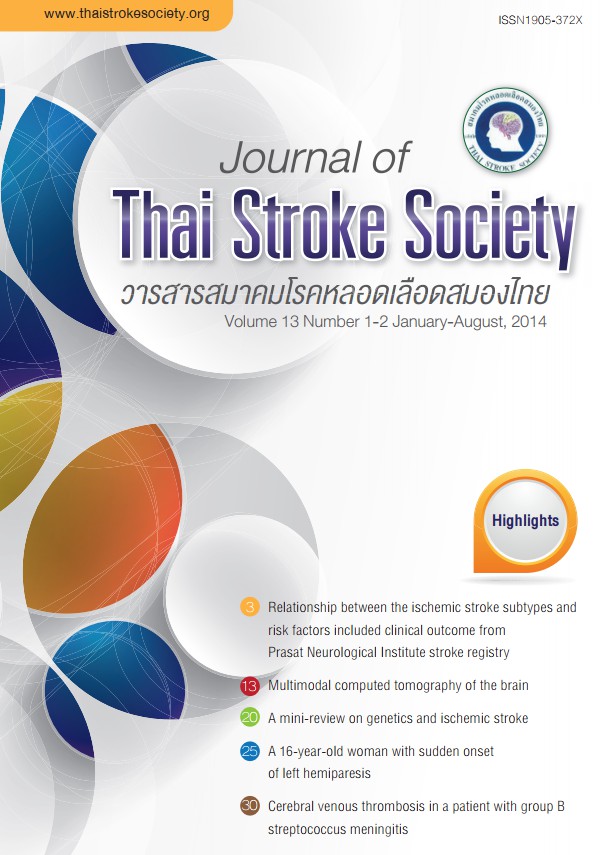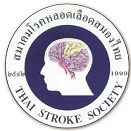Relationship between the ischemic stroke subtypes and risk factors included clinical outcome from Prasat Neurological Institute stroke registry
Keywords:
Stroke, Stroke subtypesAbstract
Background and Purpose - The etiologies of ischemic stroke affect prognosis, outcomes and treatments of patients. The objective of this study is to look for the differences in risk factors, stroke severities, complications, treatments and prognosis in each stroke subtype. Methods - We prospectively studied 140 consecutive patients with acute ischemic stroke [37.9% women, median age of 61.5 (53-72) years] from June, 2013 to August, 2013. All patients were categorized by TOAST (Trial of Org 10172 in Acute Stroke Treatment) stroke subtypes, based on the MRI Imaging; Small vessel Atherosclerosis (SAO), Large vessel Atherosclerosis (LAA), Cardiac Embolism (CE), Other Determined etiology (OD) and other Undetermined etiology (UND). Results - This study found that the age, severity, complications, treatment strategies, costs and outcomes were significantly different in each subtype of stroke (p< 0.001). SAO (45%) was most often found in our study. Patients with CE were older (68.5 years old) than those with other subtypes and patients with OD were the youngest (mean age of 39). Prevalence of obesity (33.3%), complications and also higher cost were found more common in patients with CE than those of SAO and LAA. The treatments with intravenous thrombolytic (11.1%) and anticoagulant (83.3%) were prescribed more common in patients with CE. The good clinical outcome (mRS 0-2) was more often found in SAO subtype than in LAA and CE subtype. Conclusions - Risk factor profiles, treatment, clinical outcome and prognosis of each stroke subtype are different. Treatments and prevention should be optimized for each subtype.
References
Gunarathne A, Patel JV, Gammon B, et al. Ischemic stroke in South Asians: a review of the epidemiology, pathophysiology, and ethnicity-related clinical
features. Stroke 2009;40:e415-423.
Turin TC, Kita Y, Rumana N, et al. Ischemic stroke subtypes in a Japanese population: Takashima Stroke Registry, 1988-2004. Stroke 2010;41:1871-1876.
Adams HP, Jr., Bendixen BH, Kappelle LJ, et al. Classification of subtype of acute ischemic stroke. Definitions for use in a multicenter clinical trial. TOAST. Trial of Org 10172 in Acute Stroke Treatment. Stroke 1993;24:35-41.
Hanchaiphiboolkul S. Risk factors for early infection after an acute cerebral infarction. J Med Assoc Thai 2005;88:150-155.
Chinwatanakul S, Boonyapisit K, Pornsriniyom D, Proyoonwiwat N, Senanarong V, Chaisevikul R, et al. Siriraj Acute Stroke Unit: 10 years experience. J Med Assoc Thai 2012;95 Suppl 2:S235-244.
Kolominsky-Rabas PL, Weber M, Gefeller O, et al. Epidemiology of ischemic stroke subtypes according to TOAST criteria: incidence, recurrence, and long-term survival in ischemic stroke subtypes: a population-based study. Stroke 2001;32:2735-2740.
Grau AJ, Weimar C, Buggle F, et al. Risk factors, outcome, and treatment in subtypes of ischemic stroke: the German stroke data bank. Stroke 2001;32:2559-2566.
Murat Sumer M, Erturk O. Ischemic stroke subtypes: risk factors, functional outcome and recurrence. Neurol Sci 2002;22:449-454.
White H, Boden-Albala B, Wang C, et al. Ischemic stroke subtype incidence among whites, blacks, and Hispanics: the Northern Manhattan Study. Circulation
2005;111:1327-1331.
Ohira T, Shahar E, Chambless LE, et al. Risk factors for ischemic stroke subtypes: the Atherosclerosis Risk in Communities study. Stroke 2006;37:2493-2498.
Bejot Y, Caillier M, Ben Salem D, et al. Ischaemic stroke subtypes and associated risk factors: a French population based study. J Neurol Neurosurg Psychiatry 2008;79:1344-1348.
Michel P, Odier C, Rutgers M, et al. The Acute STroke Registry and Analysis of Lausanne (ASTRAL): design and baseline analysis of an ischemic stroke registry
including acute multimodal imaging. Stroke 2010;41:2491-2498.
Ihle-Hansen H, Thommessen B, Wyller TB, et al. Risk factors for and incidence of subtypes of ischemic stroke. Functional neurology. 2012;27:35-40.
Lavados PM, Sacks C, Prina L, et al. Incidence, case-fatality rate, and prognosis of ischaemic stroke subtypes in a predominantly Hispanic-Mestizo population in Iquique, Chile (PISCIS project): a community-based incidence study. Lancet Neurol 2007;6:140-148.
Seet RC, Friedman PA, Rabinstein AA. Prolonged rhythm monitoring for the detection of occult paroxysmal atrial fibrillation in ischemic stroke of unknown cause. Circulation 2011;124:477-486.
Lisabeth LD, Brown DL, Hughes R, et al. Acute stroke symptoms: comparing women and men. Stroke 2009;40:2031-2036.
Tanizaki Y, Kiyohara Y, Kato I, et al. Incidence and risk factors for subtypes of cerebral infarction in a general population: the Hisayama study. Stroke 2000;31:2616-2622.
Jackson C, Sudlow C. Are lacunar strokes really different? A systematic review of differences in risk factor profiles between lacunar and nonlacunar infarcts. Stroke 2005;36:891-901.
Air EL, Kissela BM. Diabetes, the metabolic syndrome, and ischemic stroke: epidemiology and possible mechanisms. Diabetes care 2007;30:3131-3140.
Navaratna D, Guo SZ, Hayakawa K, et al. Decreased cerebrovascular brain-derived neurotrophic factor-mediated neuroprotection in the diabetic brain. Diabetes 2011;60:1789-1796.
Bowman TS, Sesso HD, Ma J, et al. Cholesterol and the risk of ischemic stroke. Stroke 2003;34:2930-2934.
Tirschwell DL, Smith NL, Heckbert SR,et al. Association of cholesterol with stroke risk varies in stroke subtypes and patient subgroups. Neurology 2004;63:1868-1875.
Laloux P, Galanti L, Jamart J. Lipids in ischemic stroke subtypes. Acta Neurol Belg 2004;104:13-19.
Oksala NK, Heikkinen M, Mikkelsson J, et al. Smoking and the platelet fibrinogen receptor glycoprotein IIb/IIIA PlA1/A2 polymorphism interact in the risk of lacunar stroke and midterm survival. Stroke 2007;38:50-55.
Peters SA, Huxley RR, Woodward M. Smoking as a risk factor for stroke in women compared with men: a systematic review and meta-analysis of 81 cohorts,
including 3,980,359 individuals and 42,401 strokes. Stroke 2013;44:2821-2828.
Kim J, Gall SL, Dewey HM, et al. Baseline smoking status and the long-term risk of death or nonfatal vascular event in people with stroke: a 10-year
survival analysis. Stroke 2012;43:3173-3178.
Djousse L, Ellison RC, Beiser A, et al. Alcohol consumption and risk of ischemic stroke: The Framingham Study. Stroke 2002;33:907-912.
Mostofsky E, Burger MR, Schlaug G, et al. Alcohol and acute ischemic stroke onset: the stroke onset study. Stroke 2010;41:1845-1849.
Mohsenin V. Sleep-related breathing disorders and risk of stroke. Stroke 2001;32:1271-1278.
Jood K, Jern C, Wilhelmsen L, et al. Body mass index in mid-life is associated with a first stroke in men: a prospective population study over 28 years.
Stroke 2004;35:2764-2769.
Park JW, Lee SY, Kim SY, et al. BMI and stroke risk in Korean women. Obesity 2008;16:396-401.
Sandercock P, Bamford J, Dennis M, et al. Atrial fibrillation and stroke: prevalence in different types of stroke and influence on early and long term prognosis (Oxfordshire community stroke project). BMJ 1992;305:1460-1465.
Jorgensen HS, Nakayama H, Reith J, et al. Acute stroke with atrial fibrillation. The Copenhagen Stroke Study. Stroke 1996;27:1765-1769.
Lin HJ, Wolf PA, Kelly-Hayes M, et al. Stroke severity in atrial fibrillation. The Framingham Study. Stroke 1996;27:1760-1764.
Hornig CR, Bauer T, Simon C, et al. Hemorrhagic transformation in cardioembolic cerebral infarction. Stroke 1993;24:465-468.
Molina CA, Montaner J, Abilleira S, et al. Timing of spontaneous recanalization and risk of hemorrhagic transformation in acute cardioembolic stroke. Stroke
2001;32:1079-1084.
Dromerick A, Reding M. Medical and neurological complications during inpatient stroke rehabilitation. Stroke 1994;25:358-361.
Roth EJ, Lovell L, Harvey RL, et al. Incidence of and risk factors for medical complications during stroke rehabilitation. Stroke 2001;32:523-529.
Yoneda Y, Uehara T, Yamasaki H, et al. Hospital-based study of the care and cost of acute ischemic stroke in Japan. Stroke 2003;34:718-724.
Downloads
Published
How to Cite
Issue
Section
License
ข้อความภายในบทความที่ตีพิมพ์ในวารสารสมาคมโรคหลอดเลือดสมองไทยเล่มนี้ ตลอดจนความรับผิดชอบด้านเนื้อหาและการตรวจร่างบทความเป็นของผู้นิพนธ์ ไม่เกี่ยวข้องกับกองบรรณาธิการแต่อย่างใด การนำเนื้อหา ข้อความหรือข้อคิดเห็นของบทความไปเผยแพร่ ต้องได้รับอนุญาตจากกองบรรณาธิการอย่างเป็นลายลักษณ์อักษร ผลงานที่ได้รับการตีพิมพ์ในวารสารเล่มนี้ถือเป็นลิขสิทธิ์ของวารสาร





